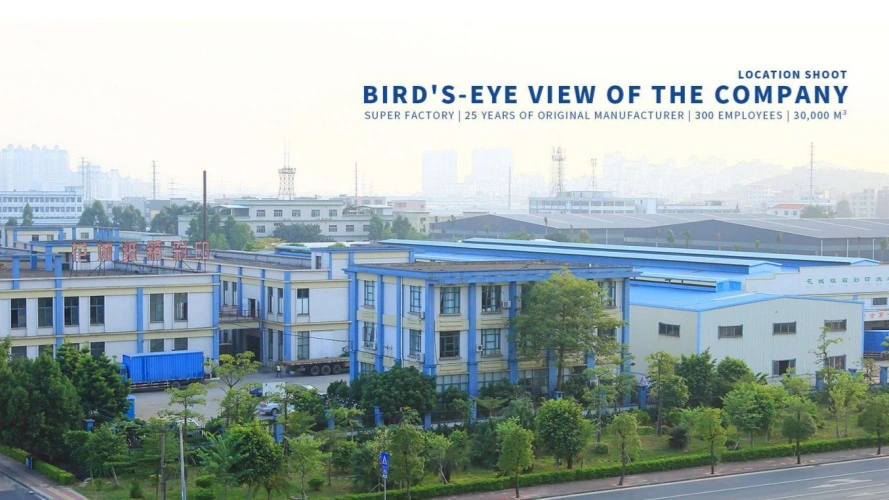How to Store and Organize Your Foldable Rigid Boxes Efficiently?
Picture this scenario: you're standing in your warehouse or storage facility, surrounded by towering stacks of rigid boxes that seem to multiply daily. These boxes consume valuable floor space, create inefficient workflows, and make inventory management a constant headache. The solution lies in understanding how to properly store and organize your Foldable Rigid Boxes efficiently. Unlike traditional rigid packaging that maintains its shape permanently, foldable rigid boxes offer a revolutionary approach to space optimization while preserving the premium quality your products deserve. This comprehensive guide will transform your storage challenges into streamlined operations, helping you maximize space utilization, reduce storage costs by up to 60%, and create organized systems that enhance productivity and accessibility.

Understanding the Fundamentals of Foldable Rigid Box Storage
When it comes to efficient storage solutions, Foldable Rigid Boxes represent a paradigm shift in packaging technology. These innovative containers combine the structural integrity of traditional rigid boxes with the space-saving benefits of collapsible design. The key to successful storage lies in understanding their unique characteristics and leveraging their collapsible nature effectively. Unlike standard rigid packaging that maintains its dimensional footprint regardless of use, these boxes can be compressed flat when empty, reducing storage volume by over 60% compared to traditional alternatives. The foundation of efficient storage begins with proper preparation. Before storing your Foldable Rigid Boxes, ensure they are completely clean and dry to prevent moisture-related damage or contamination. Inspect each box for structural integrity, checking corners, edges, and folding mechanisms to identify any potential issues that could affect future performance. This preliminary assessment helps maintain quality standards and prevents storage of compromised packaging materials that could impact your product presentation.
-
Size Classification and Systematic Organization
Professional storage management requires systematic categorization based on box dimensions and intended applications. Large Foldable Rigid Boxes, typically designed for products with heights ranging from 100-150mm, require different storage considerations than their medium and tiny counterparts. Create designated storage zones for each size category, with clear labeling systems that enable quick identification and retrieval. This systematic approach reduces search time, minimizes handling errors, and maintains inventory accuracy. The three-tier classification system provides optimal organization efficiency. Large boxes should be stored in easily accessible lower sections due to their weight and handling requirements. Medium boxes, suitable for products measuring 50-100mm in height, can be stored in mid-level sections for balanced accessibility and space utilization. Tiny boxes, designed for products ranging 20-50mm in height, are ideal for upper storage levels where their lightweight nature facilitates safe retrieval without compromising worker safety or operational efficiency.
Strategic Storage Layout Design for Maximum Efficiency
Implementing a strategic storage layout transforms chaotic box storage into a well-orchestrated system that maximizes both space utilization and operational efficiency. The cornerstone of effective storage design lies in creating designated zones that accommodate different box sizes while maintaining clear pathways for safe navigation and efficient retrieval. Your storage layout should incorporate a logical flow pattern that minimizes travel time between frequently accessed sections while ensuring adequate space for material handling equipment. Consider implementing a zone-based storage system that segregates Foldable Rigid Boxes according to their intended use, frequency of access, and dimensional characteristics. High-turnover inventory should occupy prime storage locations near main access points, while seasonal or occasional-use boxes can be stored in more remote areas. This strategic positioning reduces labor costs, minimizes handling time, and improves overall warehouse productivity.
-
Vertical Storage Optimization Techniques
Vertical space utilization represents one of the most effective methods for maximizing storage capacity without expanding facility footprint. When implementing vertical storage for Foldable Rigid Boxes, prioritize structural stability by placing heavier, larger boxes at the bottom of stacking configurations. This foundation approach prevents structural collapse and ensures safe access to boxes stored at various heights. Install appropriate shelving systems that can accommodate the weight distribution and dimensional variations of different box sizes. Adjustable shelving provides flexibility for changing inventory requirements while maintaining organized storage patterns. Ensure adequate clearance between shelf levels to facilitate easy box insertion and removal without compromising packaging integrity. Safety considerations must include proper ladder placement, clear sight lines, and adequate lighting for all storage levels.
Climate Control and Environmental Protection Strategies
Environmental factors significantly impact the longevity and performance of Foldable Rigid Boxes, making climate control an essential component of efficient storage management. Temperature fluctuations, humidity variations, and exposure to direct sunlight can compromise the structural integrity of packaging materials, affecting their folding mechanisms and overall durability. Implementing proper environmental controls protects your investment while ensuring consistent product quality. Maintain storage environments within recommended temperature ranges, typically between 60-75°F (15-24°C), to prevent material expansion and contraction that could affect folding precision. Humidity control becomes particularly crucial for boxes manufactured from paper-based substrates like SBS C1S or CCNB materials, as excessive moisture can cause warping, weakening, and compromised structural integrity.
-
Protective Covering and Barrier Systems
Implement protective covering systems to shield stored Foldable Rigid Boxes from dust accumulation, moisture exposure, and potential contamination. Breathable fabric covers or plastic sheeting can provide adequate protection while allowing air circulation that prevents moisture buildup. For premium packaging applications requiring pristine presentation, consider individual box sleeves or protective wrapping that maintains visual appeal while providing environmental protection. Air quality management plays a crucial role in preserving packaging integrity. Install adequate ventilation systems that prevent stagnant air conditions while filtering out particulate matter that could settle on stored boxes. Regular air circulation prevents the development of musty odors or mold growth that could transfer to packaging materials and ultimately affect product presentation.
Inventory Management and Tracking Systems
Effective inventory management transforms storage efficiency from a reactive process into a proactive system that anticipates needs and prevents shortages or overstocking situations. Modern inventory tracking systems enable real-time monitoring of Foldable Rigid Box quantities, locations, and usage patterns, providing valuable data for optimizing storage allocation and purchasing decisions. Implement barcode or QR code systems that enable rapid identification and tracking of individual box batches or production runs. This technological approach reduces manual counting errors, accelerates inventory audits, and provides detailed usage analytics that inform future storage planning decisions. Digital tracking systems can monitor box movement patterns, identifying frequently accessed items that would benefit from premium storage locations.
-
Automated Replenishment and Ordering Systems
Establish automated replenishment thresholds that trigger reordering processes before inventory levels become critically low. These systems analyze historical usage patterns, seasonal variations, and projected demand to maintain optimal inventory levels without overcommitting storage space or working capital. Integration with supplier systems can streamline the ordering process, reducing administrative overhead while ensuring consistent supply availability. Consider implementing just-in-time inventory principles for Foldable Rigid Boxes with predictable usage patterns. This approach minimizes storage requirements while maintaining adequate supply levels for operational continuity. However, balance these efficiencies against the need for buffer stock that accommodates unexpected demand spikes or supply chain disruptions.
Material Handling Equipment and Safety Protocols
Proper material handling equipment ensures safe, efficient movement of Foldable Rigid Boxes while minimizing physical strain on warehouse personnel and reducing the risk of packaging damage during storage and retrieval operations. The selection of appropriate equipment depends on box dimensions, weight characteristics, storage height requirements, and facility layout constraints. Invest in equipment specifically designed for handling packaging materials, such as specialized box carts, adjustable-height platforms, and gentle-grip handling tools that prevent crushing or deformation during transport. For facilities with significant vertical storage requirements, consider electric or hydraulic lifting systems that enable safe access to upper storage levels while maintaining ergonomic working conditions for personnel.
-
Safety Training and Best Practices
Comprehensive safety training ensures all personnel understand proper handling techniques, equipment operation procedures, and emergency response protocols. Regular training sessions should cover lifting techniques, equipment maintenance, hazard recognition, and injury prevention strategies specific to packaging material handling. Document all training activities and maintain certification records to ensure compliance with occupational safety regulations. Establish clear safety protocols for accessing stored Foldable Rigid Boxes at various heights and locations. These protocols should include equipment inspection requirements, personal protective equipment standards, and emergency evacuation procedures. Regular safety audits and incident reporting systems help identify potential hazards before they result in accidents or injuries.
Cost Optimization Through Efficient Storage Practices
Strategic storage management directly impacts operational costs through reduced space requirements, improved labor efficiency, and minimized packaging waste. Foldable Rigid Boxes offer inherent cost advantages through their space-saving design, but realizing maximum benefits requires thoughtful implementation of storage best practices that leverage these advantages effectively. Calculate the total cost of ownership for your storage system, including facility costs, equipment investments, labor requirements, and material handling expenses. Compare these costs against the benefits achieved through improved space utilization, reduced inventory carrying costs, and enhanced operational efficiency. This analysis provides quantifiable justification for storage system investments and identifies areas for further optimization.
-
Return on Investment Analysis
Document measurable improvements in storage efficiency, labor productivity, and space utilization to quantify the return on investment from optimized storage practices. Track metrics such as storage density improvements, reduced retrieval times, decreased labor costs, and minimized packaging damage rates. These measurements provide concrete evidence of system effectiveness and support decision-making for future storage investments. Monitor long-term trends in storage requirements, usage patterns, and operational costs to identify opportunities for continuous improvement. Regular analysis of these metrics enables proactive adjustments to storage strategies before inefficiencies develop into significant cost burdens or operational constraints.
Quality Control and Maintenance Procedures
Maintaining the quality and functionality of stored Foldable Rigid Boxes requires systematic inspection and maintenance procedures that identify potential issues before they compromise packaging performance. Regular quality assessments ensure stored boxes maintain their structural integrity, folding mechanisms operate smoothly, and visual appearance meets brand standards. Establish routine inspection schedules that examine representative samples from different storage locations and time periods. These inspections should assess structural condition, folding mechanism functionality, surface quality, and overall appearance. Document findings to identify patterns that might indicate storage environment issues, handling problems, or material degradation over time.
-
Preventive Maintenance Protocols
Implement preventive maintenance protocols that address common storage-related issues before they impact box performance. These protocols might include periodic repositioning of long-term storage items, environmental monitoring and adjustment, cleaning procedures for storage areas, and equipment maintenance schedules for handling systems. Develop standard operating procedures for addressing identified quality issues, including criteria for determining whether boxes require reconditioning, replacement, or can continue in service. Clear guidelines ensure consistent decision-making and prevent the use of compromised packaging that could affect product presentation or protection.
Conclusion
Efficient storage and organization of Foldable Rigid Boxes transforms operational challenges into competitive advantages through systematic planning, strategic implementation, and continuous optimization. By understanding the unique characteristics of these innovative packaging solutions and implementing comprehensive storage strategies, businesses can achieve significant cost savings, improved operational efficiency, and enhanced inventory management. The key lies in recognizing that proper storage goes beyond simply finding space – it involves creating systems that maximize the inherent benefits of foldable design while maintaining quality standards and operational safety.
Cooperate with GUANGZHOU FETCHING COLOR PRINTING & PACKAGING LTD.
Established in 1999, Guangzhou Fetching Color Printing & Packaging Co., Ltd. brings over two decades of packaging expertise to your storage optimization challenges. Our 50,000㎡ manufacturing facility houses advanced production equipment including KBA106-(9+1) UV printing machines, Heidelberg XL162-6L printing systems, and automated gift box production lines. With more than 300 skilled employees and a team of over ten packaging engineers, we deliver comprehensive solutions that address both your immediate packaging needs and long-term storage efficiency goals.
Our proprietary Foldable Rigid Boxes technology represents the pinnacle of space-saving packaging innovation. Available in Large, Medium, and Tiny sizes to accommodate products ranging from 20mm to 150mm in height, these patent-protected designs deliver over 60% storage cost savings compared to traditional rigid packaging. Each box undergoes precision manufacturing using premium materials including SBS C1S, SBS C2S, CCNB, and specialty metallic substrates, ensuring exceptional durability and visual appeal.
As a leading China Foldable Rigid Boxes factory and trusted China Foldable Rigid Boxes supplier, we maintain ISO14001-2015, ISO9001-2015, FSC, and Disney certifications that guarantee consistent quality and environmental responsibility. Our China Foldable Rigid Boxes manufacturer capabilities extend to complete customization including hot foil stamping, UV coating, embossing, and specialized surface treatments. Whether you need High Quality Foldable Rigid Boxes for luxury cosmetics or cost-effective solutions for retail applications, our competitive Foldable Rigid Boxes price structure and China Foldable Rigid Boxes wholesale options provide exceptional value. Contact us at public@fetchingprinting.com to discover how our Foldable Rigid Boxes for sale can revolutionize your storage efficiency.
FAQ
Q: What is the maximum weight capacity for stacking Foldable Rigid Boxes?
A: The stacking capacity depends on box size and material composition, but our Large boxes typically support up to 50kg when properly stacked, while Medium and Tiny boxes support 30kg and 20kg respectively.
Q: How much storage space can be saved using Foldable Rigid Boxes compared to traditional rigid packaging?
A: Foldable Rigid Boxes can reduce storage space requirements by over 60% compared to traditional rigid boxes and 20-30% compared to standard collapsible alternatives when stored in their flat configuration.
Q: What environmental conditions are optimal for storing Foldable Rigid Boxes long-term?
A: Maintain temperature between 60-75°F (15-24°C) with relative humidity below 50% in clean, dry environments away from direct sunlight and chemical exposure.
Q: How often should stored Foldable Rigid Boxes be inspected for quality maintenance?
A: Implement monthly inspections for high-turnover inventory and quarterly assessments for long-term storage items to ensure structural integrity and folding mechanism functionality.
References
1. "Warehouse Management and Storage Optimization" - Johnson, M.A., International Journal of Logistics Management
2. "Sustainable Packaging Storage Solutions for Modern Warehouses" - Chen, L., Packaging Technology Review
3. "Cost-Effective Inventory Management in Manufacturing Environments" - Rodriguez, P., Industrial Engineering Quarterly
4. "Environmental Factors in Packaging Material Storage" - Williams, R.J., Materials Science and Engineering Journal

Based on your location and order quantity, you will have the opportunity to receive a limited time free shipping promotion!

Corporate Purpose
